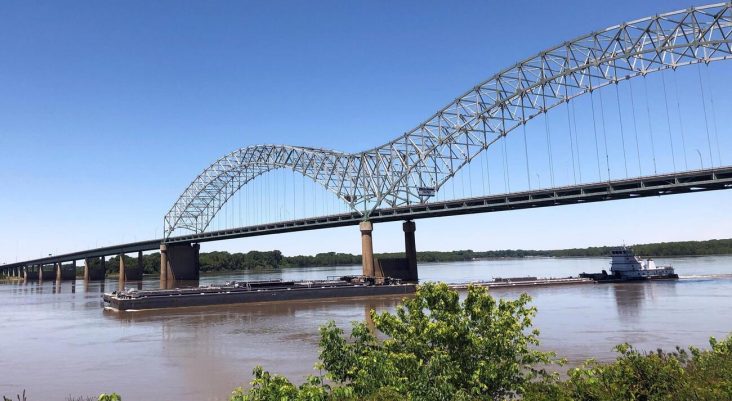Mississippi River’s low levels disrupting barge traffic, affecting farmers during harvest
by October 17, 2022 9:40 am 2,717 views

Despite rainfall in the Arkansas Delta during the weekend, the Mississippi River is getting close to all-time, historic lows and it is having an impact on farmers in the Natural State. Closures stopped a reported 2,000 barges and about 100 towboats.
The water level had gotten so low that barge traffic was stopped during the first week in October. A Talk Business & Politics reporter saw piles of soybeans that were unloaded onto an empty island and left to rot near Memphis because they could not be moved.
Barge traffic has been re-opened after river channels were dredged, but the water levels remain perilously low and local grain storage elevators are filled to near capacity.
“There’s only so much storage at the elevators, only so much space,” said Hunter Biram, extension economist with the University of Arkansas System Division of Agriculture. “Elevators will turn farmers away when they don’t have anywhere to put it.”
Harvest is underway in Arkansas. According to the National Agricultural Statistics Service, 8% of the state’s soybeans have been harvested as of Oct. 11. That compared to 20% at this time last year and the 19% five-year average. Harvest for corn was at 97% and 90% for rice.
Soybeans with nowhere to go were being piled high at the terminal at Helena-West Helena last week, with trucks lined up waiting to unload. Nearly half of Arkansas’ soybeans are exported. The growing stockpile, coupled with uncertainty about when the traffic will be able to move down the Mississippi River through New Orleans, will likely erode prices farmers would get at the elevator.
“In these instances, basis weakens when there’s a lot of grain on hand,” Biram said. “With rising barge rates, it’s more expensive to ship grain downriver. Grain elevators will bid lower and offer less for grain to account for the higher cost of shipping grain down the river.”
Biram said that basis last week was down $1.30 for soybeans and was about the same for corn. Basis is the difference between a local cash price and the futures market price. There was a little bit of a rally as dredging of the river began to free up some traffic, but basis was still down 75-cents. Last year, basis was down 25-cents at the same time.
“With lower prices at the elevator, if farmers have storage, they should store their rain and sell it later when they might be able to get a better price,” he said.
Harvest aside, the other worry with the low river is that while crops are headed toward New Orleans for export, this is the time when fertilizer typically makes its way upriver for next season’s crops.
“The biggest issue is planning for next year,” he said. “With fertilizer that cost is already high and we don’t know yet how much higher that could go. There could be a big rain next week and alleviate all that.”
The Climate Prediction Center is showing a near-normal precipitation outlook for the next eight to 14 days. The seasonal precipitation outlook is less optimistic, showing Arkansas with a below-average chance for precipitation through December.
The river gauge at Osceola is now at its lowest since the all-time low record was set in 1988, according to CNN. The river’s level near Memphis is the third lowest ever recorded, and is predicted to fall to its second lowest ever as drought conditions are predicted in the coming weeks by the National Weather Service.
